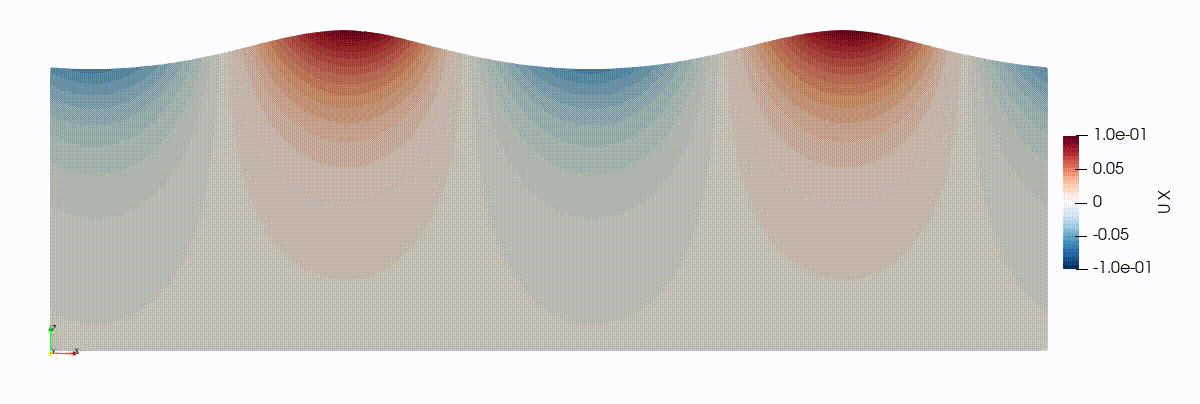The geometricVoFCartesian is an extension library improving two-phase-flow functionalities in OpenFOAM. It features conventional and machine-learning methods to estimate the normal vector and curvature of the fluid-fluid interfaces in geometric Volume-of-Fluid (VoF) framework.
Available methods are as follows:
- Interface normal vector: Youngs' Method, Central-Columns Differences Method, Mixed Youngs-Central Method
- Interface curvature: Height Function Method, Multilayer-Perceptron (MLP) models (only in 2D currently)
The methods are designed for uniform (isotropic) Cartesian grids. In cases where the interface motion occurs in a smaller subset of the domain, the uniform grid can also be restricted to a smaller zone containing the interface. This is currently achieved using the cellSet functionality. The rest of the domain can use generic unstructured grids.
ijkZone: Creation and manipulation of the regular-grid zone containing the interface motions.multilayerPerceptron: Basic functionalities and data structures for an MLP. Implementation is done using exclusively the C++ Standard Library. Thus, no additional package is required to use new machine learning models.uniformStencil: Parallel operations on local cell blocks.interfaceForces: Base class for new curvature models.
interIsoCartFoam: Extension to interIsoFoam to feature newly implemented curvature models.
Machine learning models employ deep MLP architectures to estimate the interfacial curvarture. Two different types of models are developed:
- SymMLP: the symmetry-preserving MLP model using bias-free neurons
- StdMLP: the standard MLP model
The models are available in benchmarks/casesOF/2D/mlpCurvatureModels. Training datasets can be shared upon request.
The code to develop MLP models can be found in tensorflow directory. The general procedure can be summarized as follows:
- A synthetic dataset composed of circular arcs of varying sizes is generated:
bash tensorflow/scripts/genCircles.sh
- Around hundred different models are trained with mini-batch optimization:
bash tensorflow/scripts/mlpTrain.sh
- The weights and biases of the TensorFlow models are converted to raw text format, e.g.,
python tensorflow/TfToTxt.py mlpCurvatureModels SymMLP
The multilayerPerceptron class in OpenFOAM reads these txt files and constructs the corresponding MLP model.
- The best performing models are selected after conducting analytical tests in python environment (cf. Jupyter Notebooks in /benchmarks/analyticShapes), and standard benchmark tests in OpenFOAM (cf. benchmarks/casesOF/2D).
The technical details are elaborated in Önder & Liu (2023).
OpenFOAM v2006 or above must be installed:
https://www.openfoam.com/download/release-history
git clone https://github.com/asimonder/geometricVoFCartesian.git
cd geometricVoFCartesian
./Allwclean
./Allwmake
The library exclusively works on Cartesian zones. Class ijkZone handles the regular-grid functionality. It requires the cellset where the interface is located to be specified. If cyclic BCs are considered, they need to defined as well. The dictionary is located in system/ijkDict:
{
cellSet refinedCells;
cyclicX true;
}
If the grid is uniform everywhere in the domain, then simply use "cellSet domain;".
New curvature-estimation models are configured in system/curvatureDict, e.g., for the height function method,
curvatureModel heightFunction;
heightFunctionParams
{
nMax 3;
}
Here, nMax is the number of cells neighbouring the central cell in one direction. For instance, if the height function is obtained from 7 cells along the height, then nMax=3 so that 3+1+3=7. This yields 7x3x3 stencil in 3D.
MLP model is configured as follows:
curvatureModel mlpCurvature;
mlpParams
{
mlpModel "../../mlpCurvatureModels/SymMLP";
interfaceTol 1e-3;
zonalModel true;
useScaling true;
xoffsetInput 0;
gainInput 2;
yminInput -1;
yminOutput 0.;
gainOutput 1.0;
xoffsetOutput 0.0;
}
mlpModel specifies the full path to txt files containing weights and biases of the model. interfaceTol is the volume-fraction threshold for curvature to be non-zero. zonalModel has to be set true for symmetry-preserving MLP. If the MLP model uses input-output scaling, then useScaling is set to true, and xoffsetInput, gainInput, yminInput, yminOutput, gainOutput and xoffsetOutput have to be specified.
Several benchmark cases are provided in benchmarks/casesOF directory:
- 2D: stationary bubble, rising bubble, standing capillary wave, parasitic capillary ripples. See Sec. 5 in Önder & Liu (2023) for results.
- 3D: stationary bubble, translating bubble
Önder, A. & Liu, P. L.-F. (2023). Deep learning of interfacial curvature: a symmetry-preserving approach for the volume of fluid method. Journal of Computational Physics, 485(1), 112110. (pdf)
Asim Önder (asim.onder@gmail.com)
